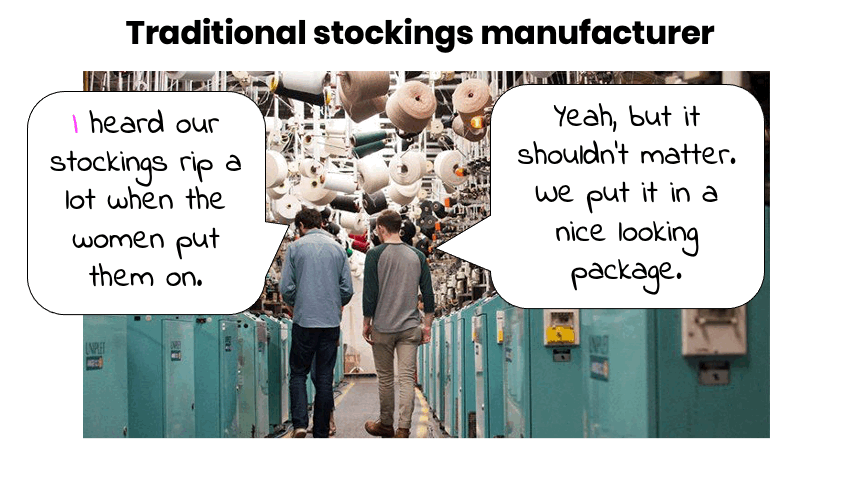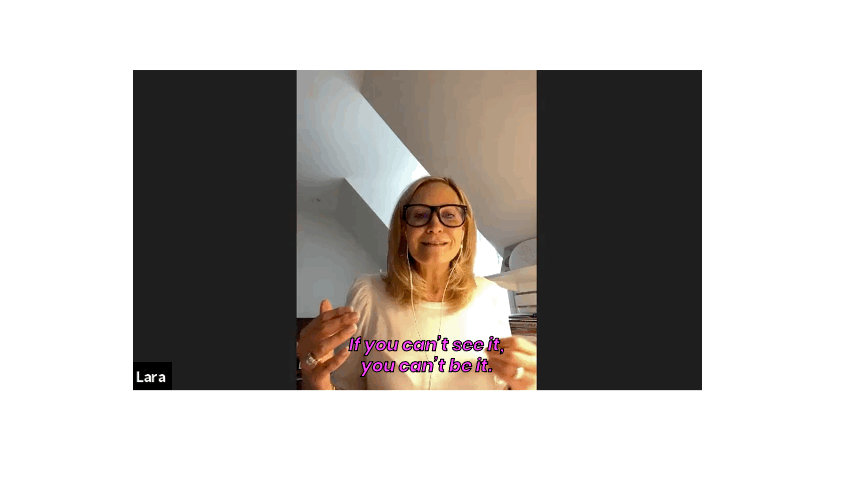👋 to the over 100 folks curious about how organizations are creating systemic change so that more can win in the game of life.
Not a subscriber? Click that pretty pink button below to join the crew.
Newsletter overload? Set your 👀 s on the charts, four gifs and Parting Words. You’ll get the answer to today’s focus: why having more women in capital markets matters and what one organization is doing about it.
(Pro-tip: Download images on your email viewer to get the full giffy experience)
Opening Spiel
I’m excited to be shifting gears to profile a solution to gender equality at the senior ranks within capital markets.
What’s doubly neat about this is that changing the gender balance has the potential to change more than a select group’s chances at an elite job. Given how central capital markets is to our overall economy, a shift in the types of people making decisions could have far reaching effects.
To understand what’s going on in, I sat down with Lara Zink, the new CEO of Women in Capital Markets. We talked about gender diversity in the industry, the impact on us and the overall economy, and what they are doing about it.
I hope it’s as eye opening for you as it is for me.
First, a 101 on sell-side capital markets
Capital markets is made up of two sides. There is the sell-side and the buy-side. On the sell-side, bankers will create, promote and sell investment products, just like a retailer. But instead of a sweater like the retailer would sell, the banker sells either equity (e.g., stocks of a company looking to IPO) or a debt (e.g., a bond that they promise to buy back in a certain amount of years for a certain price). So the main difference between a clothing retailer and a sell-side banker is that they both pitch their products as a “good investment” but only the banker’s product has the potential to increase in value (unless it is something like a designer handbag that can also appreciate over time).
The buy-side is, as you’d suspect, the customer of the sell-side. Buy-side includes pension funds, hedge funds and mutual funds that would buy the equity or debt for themselves or for another customer (like you and me) all with the aim to generate a return.
Lara and I focused a lot on the sell-side of the market. Partially because it is the most male-dominated part of the industry and partially because it is such a critical element of our economy. The sell-side is what produces the financial products we grow our wealth with. Just like a store, you can only buy what is on offer so we rely on the sell-side to come up with products that deliver good returns and good outcomes for our society.
Capital Markets is a Man’s World
So there is nothing groundbreaking in stating that Capital Markets is a man’s world. We all know this and in pre-pandemic days could see it by walking along Bay St. at lunch hour. What’s important to understand is just how male dominated it is.
To start, the numbers are heavily skewed towards more men. At the entry levels, women represent 20% of professionals. This drops to just 10% at the Managing Director, the highest level at the firms.

The gender imbalance, as it is in many male-dominated industries, is not just biological uniformity. The bigger challenge is the cultural uniformity that occurs when you have a whole group of people that share a very narrow set of characteristics.
In capital markets, the culture is epitomized by the very extreme set of masculine characteristics: authoritative, ambitious and in many cases, aggressive, boastful and brazen. If you watch any clip from Wall Street or the more recent follow-up Wolf of Wall Street you’ll see this culture in action.
As such, any candidate for a capital markets job needs to “fit” into this masculine way of acting. Not surprisingly, men are more comfortable with masculine traits and thus have the majority of capital markets jobs. Those that don’t “fit” - male or female - have to conform or step out of the running.
More women matters more than you think
So should we care that this is a high testosterone world? Some say we shouldn’t. They’d argue that on the sell-side, studies have shown that career advancement is not impacted by gender. On the buy-side female stock pickers perform the same as men. Having more women doesn’t improve performance and women aren’t discriminated against so we shouldn’t care about it. Either the person is a good banker or not and we should leave it at that.
This argument would align with peer-reviewed studies that found gender diverse boards don’t improve performance (and contradicts all the McKinsey et. al. reports that make the case for diversity). These academic studies identified that the female board members had similar values, knowledge and experience as the men and as such had a similar way of guiding the company.
So maybe they are right? Or maybe we’re just asking the wrong question.
Perhaps a better question is: what is the impact of having employees with feminine characteristics and how could this feasibly change sell-side markets?
The easiest impact is that it would make a slight dent in income inequality between men and women. A job in capital markets pays a boat ton. Like actually enough to buy a big boat. Starting salaries out of university can be $100,000 and go up to millions for Managing Directors. Half the population is essentially cut out of that earning potential, which is good enough reason to push for a more diverse employee set.
There is an even bigger reason for change when you look at the role sell-side capital markets play in our economy.
When you have just one gender and more so, as we learned above, just one very acute representation of male characteristics, then you end up with a very specific end-product from the work.
We’ve seen how different women act as government leaders, especially during the last year (shout out to our girl, Jacinda!). We’ve seen what happens when women innovate in sectors they are also consumers (witness Sheertex and Knix). We’ve seen how industries have shifted to meet the needs of the underserved female market, who now drive the world economy, according to BCG.
Within capital markets, what could more nurturing, empathetic, okay with the unknown type of sell-side bankers do to the system?
Would the debt products they create be different?
In March of this year, BMO offered a $750 million Women in Business 5-year bond. The money BMO makes from selling this bond will be used for loans to women-owned businesses. This addresses a market demand for investors, who are also women, to support economic inclusion.
This debt structure is kind of like when Tim Horton’s sells coffees on Camp Day and gives the proceeds to local camps. In the BMO example though, instead of the profits going to charity, they are lent out (for profit) to other women. BMO has used this model in 2019 for a $500 million sustainability bond that went back into funding 101 women-owned businesses, 33 indigenous owned businesses and 3 renewable energy projects.
But these efforts are just a drop in the bucket. As of their 2020 annual report, BMO had tens of billions in outstanding bonds. Think of how dramatically we could shift the quality and direction of economic growth if the majority of the proceeds from those bonds were considered within BMO’s sustainability framework. And then what would happen if all banks did this?!
Would the equity securities they issue be different?
Last year, Goldman Sachs announced they would only underwrite IPOs (i.e., help other companies sell their shares on a stock exchange) if they have at least two diverse board members. That means if you want Goldman to be your banker when you go public, you have to be at least a little conscious of who’s running the company.
Right now, only a fraction of IPOs have women founders. In the US, the number is less than 1% and it’s likely the same in Canada, where we know only 2% of the top TSX companies are led by women. Diverse board representation is better, with women taking around 20% of spots, but is usually concentrated among fewer women (read more about the ‘golden skirt phenomenon in a previous article I wrote).
Goldman’s commitment is going in the right direction. And, of course, bankers could go further than that. They could institute different criteria for evaluating a good deal, including whether the company pays living wages, which is super important to shifting inequality. Or they could actively seek out women-led businesses and provide more fodder for their friends on the buy-side making ETFs pooling together women-led companies. If a banker looks for more than just pure profit of each transaction, there are oodles of systemic changes we can make!
You have to see it to be it
So now the important question - what is Women in Capital Markets doing about all this?!
Constance L. Sugiyama founded WCM in 1995 and the team has been making great strides since then. Joining at the beginning of this year, Lara is now leading the team to continue their efforts.
Now the learnings of what WCM is doing go beyond the changes they are making in capital markets. The WCM model is a good one to study for any organization making systemic change, whether it is for profit or not-for-profit.
First, they are rooted in a social-purpose outcome. Lara is big on the idea that if you can’t see it, you can’t be it. That’s basically the goal of WCM: make capital markets a place where women can see a place for themselves and be in the game. WCM’s goal is not about growing membership or another not-for-profit equivalent of growing revenue. The aim is about the impact they will have on society, namely more women in capital markets.
Within that overall goal, they honed in on key breakdowns in the system:
Stop the drop out that happens 10+ years into a woman’s career, which usually coincides with when women have children (and most corporates have a bad way of handling).
Hyper focus on the inclusion of BIPOC and LGBTQ2S+ individuals, who are the most excluded from the group and have the most challenging experiences in capital markets firms.
Create structured networks for senior members with more than 15 years experience, akin to YPO. We know we network with people like ourselves, so while the men are more often helping each other out, women need their formal structure for investment tips, help during rough patches and the like.
Next, with their goal in mind, they build their product they deliver to the market: the 3,500 women who can enter, stay and rise in the capital markets world. They start early, filling the pipeline with high school and university students. The free SheBiz event is a great example of how they are helping women “see it so they can be it”. 1,400 high school students joined the 2020 event and got exposure to careers in business and STEM.
Once in the job market, their professional programs provide coaching, mentoring and peer support for early, mid and executive level women. A key of all the programs is that women are encouraged to be themselves since their aim isn’t just to make a bunch of people with XX chromosomes act all masculine.
You can’t conform to advance
True to their focus above, they have a specific program aimed at returning to Bay Street for women who had to leave often for family obligations. This program brings them back into the mid to senior roles they left, like Mary Ann Mendes who left as an executive director and when she came back to work four years later could only find more junior roles. After participating in the program, she was hired full time at BMO Capital Markets and then went on to co-chair the WCM program.
Women returning after an absence “have already put in their time prior to leave, so the notion that they now need to pay their dues a second time needs to be addressed and dismissed by CEOs and senior leaders.” Mary Ann Mendes, Co-Chair of WCM Return to Bay Street
All told, the program has smoothed career gaps for 74 women and got them back in the game.
The third key ingredient to the model is building demand. While the WCM team may know every and all reason why there needs to be more women in capital markets, the leaders in those firms don’t necessarily. So like any good marketer, they get out there and make sure their customer (the capital markets employers) knows how awesome their product is (the women who come out of the programs).
This starts with research. Their most recent Equity Equation report creates a compelling picture of how disparate the lived-experience is between a male and female and particularly how it differs by race and sexual orientation. You can see that people live completely different realities when it comes to perceived fairness of performance reviews, impact of parental leave, pay, harassment, and just the ability to be one’s true self. The difference is particularly striking among the junior-mid level professionals (those often with young families) as well as BIPOC and LGBTQ2s+.
They then take those reports and do presentation after presentation with senior leaders about what’s going on. On their website they call it “Inspiring and equipping senior leaders with information to drive change internally” (for me, that’s a very lovely way to put what is often a grind for anyone passionate about an issue and can see how things can be different).
Their work is paying off, though, as Lara notes that people who wouldn’t even take a meeting years ago, are bringing them in now and listening. That means mindsets are shifting and over time employers will act differently when interviewing candidates, assessing bonuses or reviewing parental leave policies to make jobs in capital markets more accessible to a female, especially the feminine type.
The outcomes of their work are moving us in the right direction. They’ve impacted tens of thousands of people since their inception, last year alone engaging over 5,000. All this has happened by being wholly and singularly focused on a purpose-driven outcome they create a product and demand our world needs.
Parting words
Former US Secretary of State, Madeleine Albright has a well-known saying: “there is a special place in hell for women who don’t support other women”.
While this isn’t the most diplomatic saying, as she has acknowledged in an NY Times Op-Ed, it’s been a calling cry for many female-empowerment efforts.
Looking at the story of Women in Capital Markets, the rationale for helping women succeed in that industry goes beyond helping a sister out.
A more diverse set of values, experiences and knowledge can change the types of companies that list on our stock exchange, the way money is used to build new businesses and more.
It’s an interesting thought exercise to reflect on regarding any industry. How would the products and services be different if people with different values, knowledge and experience were making decisions? Food for thought as we all look to building a more sustainable and inclusive economy.
Thanks to Lara and Peggy for the chats, input and insight. 🙏💕
Did you find this post mind expanding? When you grow the crew of rule breakers, it’s an amazing gift for me. 🎁
Join the crew by subscribing. 👇🥳
Share this with someone else that would enjoy it.👇🥳🥳
Till next time, Rule Breakers. Keep well and keep questioning the status quo.
🏄♀️
Jess
Ps. If you have any input on topics you’re interested in, do holler! Feedback is also helpful. I heard the gifs were a bit too fast so I’m gonna stop putting data in the gifs.










And another
https://www.nasdaq.com/press-release/nasdaq-to-advance-diversity-through-new-proposed-listing-requirements-2020-12-01